This was a period of significant change in the social and Christian spheres. Christian voices demanded change in many social settings, for example the Congregationalists founding Rochford's first town school catering for poorer children.
New Christian denominations were also emerging which emphasised the importance of Christians having a personal relationship with Jesus.
This tapestry panel looks at various aspects of Social & Christian Change in the District. It is designed as a timeline, running across the top row and then along the bottom row. Look for the clever linking of the individual events.
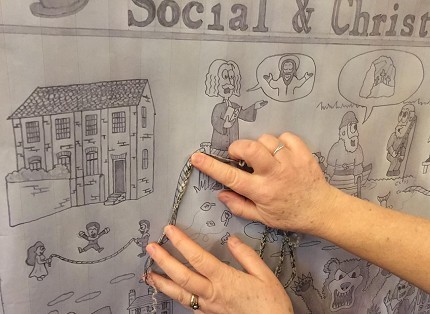
Follow the timeline from left to right across the top row. First there are children skipping below the Rochford Congregational School, founded in 1741 to bring education to the poor.
The skipping rope thickens and threads through two posts where Rev. James Pilkington, the first minister of Rayleigh Baptist Church (founded 1797), is preaching.
The rope then ties to a post at the water’s edge where fishermen from Leigh chat to Rochford fishermen in the 1820s and possibly take the opportunity to preach from the viewpoint of another new denomination, Methodism.
John Wesley, the founder of Methodism, is known to have preached in Leigh several times but didn’t come to Rochford. Some of the new Wesleyan preachers in Leigh are known to have been fishermen...one was a relative of one of those involved in making this tapestry!
One of Wesley's famous quotes still resonates today: "Do all the good you can, by all the means you can, in all the ways you can, in all the places you can, at all the times you can, to all the people you can, as long as ever you can."
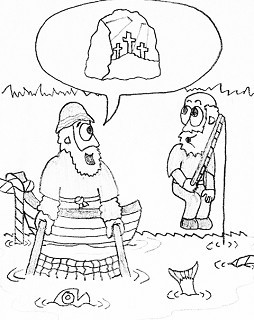
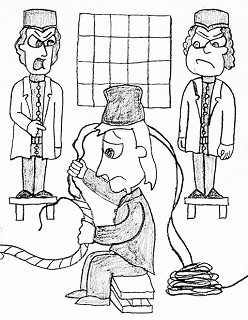
Our rope emerges from the water and we find an inmate from the Rochford Union Workhouse (opened in 1837 as a result of the 1835 Poor Law) picking oakum, flanked by wardens from the workhouse. This was a tedious and painful task which involved unpicking tarred rigging from ships, with the resulting tarred fibres used for sealing gaps in ships’ timbers.
The rope strand continues to the Rochford home of James Banyard, who in 1837 founded the Peculiar People, a Christian movement which spread rapidly across south-east Essex and became the foundation for the Evangelical Church.
Banyard faced hostility in the early days of the movement and he is shown here being soaked with water and pelted with a variety of objects.
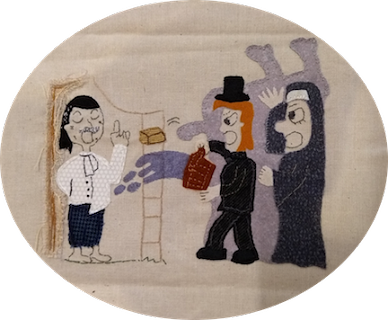
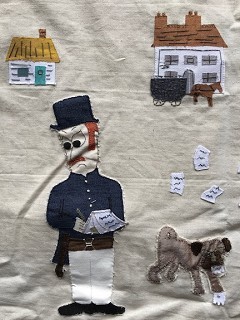
A series of watery footprints take us to the bottom timeline, where an early police officer is taking notes. The Essex County Constabulary was formed in 1840 and a few police officers were installed in Rochford and Rayleigh.
Rayleigh police operated from a thatched cottage for some time, whilst Rochford built a police station in 1846.
The right-hand of the three buildings behind the policeman is Hockley Spa - but it's not today's pub by the same name! This building was established in 1842 in an attempt to bring visitors (and income) to Hockley.
Unfortunately, the spa facilities soon closed as the fashion for visiting spas declined in favour of sea bathing at resorts such as Southend.
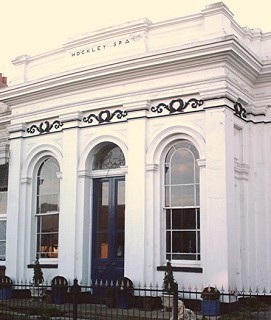

There is now a paper trail to a bearded gentleman seen making notes; this is Philip Benton (1815-98), author of The History of Rochford Hundred (1867-88).
Benton owned property in Great & Little Wakering, Shopland and Barling. He is buried in Shopland’s now-churchless churchyard and his grave can still be seen.
The paper trail leads to the middle drawing on the bottom row which shows another police officer, Rochford’s Inspector Chase, being pursued by a bear in the 1890s.
Chase was in the habit of checking on overnight outdoor sleepers who were waiting for the early coach to London and, in doing so, he once disturbed a dancing bear that was being taken to a local fair.
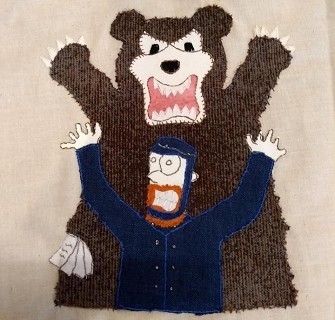
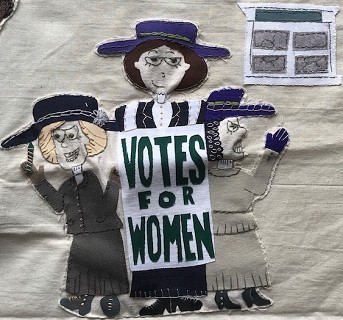
In the tapestry, Inspector Chase drops his pencil, which is picked up by the Suffragettes in the next scene.
They caused disorder across the District while campaigning for ‘Votes for Women’, including in Rayleigh in 1912 where a brick was thrown through a shop window.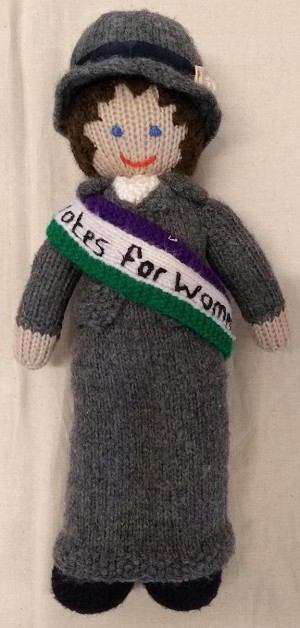
The Women’s Institute, whose logo is shown in the bottom right of the frieze, was founded in Essex in 1917.
Finally, we reach the Rayleigh Elim Church, established in 1926 following the growth of the Elim church from its foundation in 1915.
The Estuary Elim Church has been a strong supporter of this tapestry project.
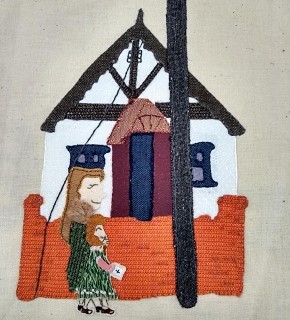
The bottom border illustrates that food changed throughout the period, e.g. oranges were popular in the 19th century then sparse during the wars; oysters were originally the common food for the poor, then later became delicacies for the rich.